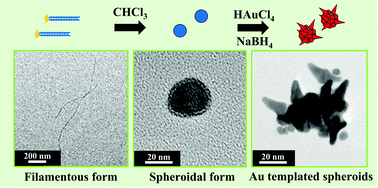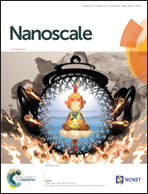M13 bacteriophage spheroids as scaffolds for directed synthesis of spiky gold nanostructures†
Abstract
The spherical form (s-form) of a genetically-modified gold-binding M13 bacteriophage was investigated as a scaffold for gold synthesis. Repeated mixing of the phage with chloroform caused a 15-fold contraction from a nearly one micron long filament to an approximately 60 nm diameter spheroid. The geometry of the viral template and the helicity of its major coat protein were monitored throughout the transformation process using electron microscopy and circular dichroism spectroscopy, respectively. The transformed virus, which retained both its gold-binding and mineralization properties, was used to assemble gold colloid clusters and synthesize gold nanostructures. Spheroid-templated gold synthesis products differed in morphology from filament-templated ones. Spike-like structures protruded from the spherical template while isotropic particles developed on the filamentous template. Using inductively coupled plasma-mass spectroscopy (ICP-MS), gold ion adsorption was found to be comparatively high for the gold-binding M13 spheroid, and likely contributed to the dissimilar gold morphology. Template contraction was believed to modify the density, as well as the avidity of gold-binding peptides on the scaffold surface. The use of the s-form of the M13 bacteriophage significantly expands the templating capabilities of this viral platform and introduces the potential for further morphological control of a variety of inorganic material systems.



 Please wait while we load your content...
Please wait while we load your content...
